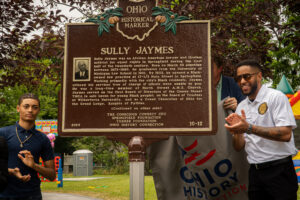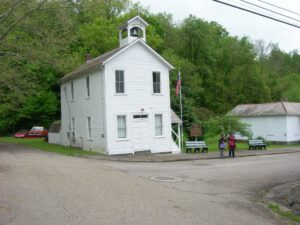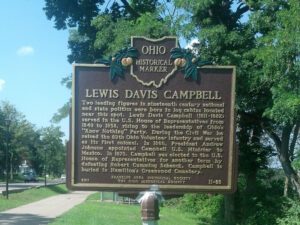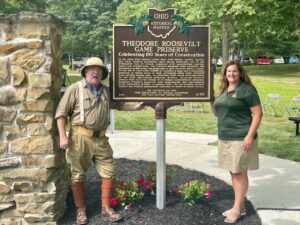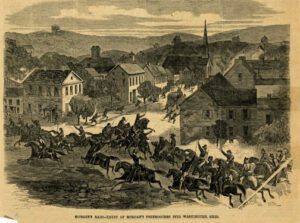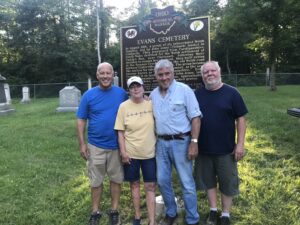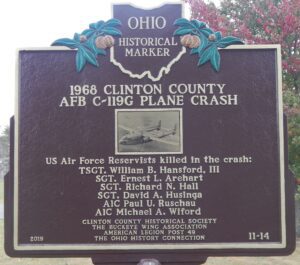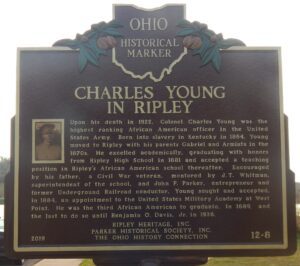, OH
Sully Jaymes was an African American lawyer and tireless activist for equal rights in Springfield during the first half of the twentieth century. Born on March 30 sometime between 1875-1880, he graduated from the University of Michigan Law School in 1901. By 1903, he opened a Black-owned law practice at 17-1/2 Main Street in Springfield. Working primarily with the city’s Black residents, Jaymes offered his services free of charge if clients were unable to pay. He was a long-time member of North Street A.M.E. Church. Jaymes served on the first Board of Directors of the Center Street YMCA (a safe-haven for young Black people), on the Board of Trustees at Wilberforce University, and as a Grand Chancellor of Ohio for the Grand Lodge, Knights of Pythias. (Continued on other side)
, OH
Established in 1879 by Chicago industrialist William P. Rend as a coal mining town, Rendville became a place where African Americans broke the color barrier. In 1888, Dr. Isaiah Tuppins, the first African American to receive a medical degree in Ohio, was elected Rendville’s mayor, also making him the first African American to be elected a mayor in Ohio. Richard L. Davis arrived in Rendville in 1882 and became active in the Knights of Labor. He was one of the labor organizers from the Little Cities of Black Diamonds region who helped found the United Mine Workers of America in 1890. An outstanding writer and orator, Davis was elected to UMWA’s national executive board and organized thousands of African Americans and immigrants to join the union. (continued on other side)
, OH
Two leading figures in nineteenth century national and state politics were born in log cabins located near this spot. Lewis Davis Campbell (1811-1882) served in the U.S. House of Representatives from 1849 to 1858, rising to the leadership of Ohio’s “Know Nothing” Party. During the Civil War he raised the 69th Ohio Volunteer Infantry and served as its first colonel. In 1866, President Andrew Johnson appointed Campbell U.S. Minister to Mexico. In 1870, Campbell was elected to the U.S. House of Representatives for another term by defeating Robert Cumming Schenck. Campbell is buried in Hamilton’s Greenwood Cemetery.
, OH
In the early 20th century Ohio’s deer, wild turkey, beaver, bobcat, and other wildlife populations were facing extinction due to the widespread loss of forests combined with uncontrolled hunting. Ohio’s first wildlife area, The Theodore Roosevelt Game Preserve, was established in 1922 under the leadership of Ohio Governor Harry L. Davis. Its aim was to reestablish wildlife by creating a game and reforestation preserve on 15,000 acres of land, purchased using funds collected from hunting license fees. An additional 5,000 acres were purchased by the state agricultural extension division. Roosevelt Preserve quickly lived up to the dreams of its famous conservationist namesake, President Theodore Roosevelt, with programming that reestablished Ohio’s extirpated wildlife. A century later, the partnership between hunters and wildlife management continues to thrive in Scioto County.
, OH
General John Hunt Morgan led 2,000 Confederate cavalrymen into Meigs County on July 18, 1863, during a 45-day raid north of the Ohio River. In pursuit, Union forces under Gen. James M. Shackelford and Col. Frank L. Wolford deployed near Bashan Church on the morning of July 19. Near this point five regiments of Kentucky cavalry and the 45th Ohio Mounted Infantry met Confederates retreating from the battle at Buffington Island, three miles east. During this skirmish, Confederate Colonels Richard C. Morgan, William W. Ward, and D. Howard Smith surrendered their commands, numbering about 400 men and officers.
, OH
In August 1818, a group of six interrelated Welsh families, led by John Jones (Tirbach) landed in Gallipolis. They journeyed from Cardiganshire, South Wales destined for the Welsh settlement at Paddy’s Run, near Cincinnati. Following their decision to remain here instead, they built cabins in the Symmes Creek Valley on the old Welsh road between Centerville and Oak Hill. The group became the nucleus for later Welsh settlement, as the area became known as “Little Cardiganshire.” Evans Cemetery is on land set aside by John Jones, later owned by grandson Timothy Evans. Approximately 50 souls lie here, several in unmarked graves.
, OH
On August 9, 1968, a plane carrying 31 military passengers and crew members left the Clinton County Air Force Base for completion of an annual two-week active duty training held at Otis Air Force Base, Massachusetts. The transport was assigned to the 907th Tactical Airlift Group, 302nd Tactical Airlift Wing. Just after takeoff, the C-119G “Flying Boxcar” lost power, and the pilot attempted to return to the base. The plane crash-landed and caught fire on the Ottie Griffith Farm two miles from the base. Six reservists perished, and many passengers and rescuers were injured.
, OH
Charles Young in Ripley. Upon his death in 1922, Colonel Charles Young was the highest ranking African American officer in the United States Army. Born into slavery in Kentucky in 1864, Young moved to Ripley with his parents Gabriel and Arminta in the 1870s. He excelled academically, graduating with honors from Ripley High School in 1881 and accepted a teaching position in Ripley’s African American school thereafter. Encouraged by his father, a Civil War veteran, mentored by J. T. Whitman, superintendent of the school, and John P. Parker, entrepreneur and former Underground Railroad conductor, Young sought and accepted, in 1884, an appointment to the United States Military Academy at West Point. He was the third African American to graduate, in 1889, and the last to do so until Benjamin O. Davis, Jr. in 1936.


